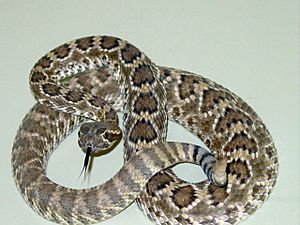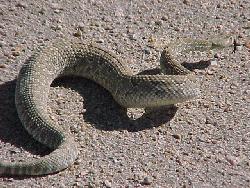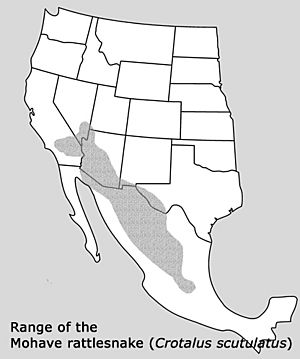Crotalus scutulatus facts for kids
Quick facts for kids Crotalus scutulatus |
|
|---|---|
 |
|
| Conservation status | |
| Scientific classification | |
| Genus: |
Crotalus
|
| Species: |
scutulatus
|
| Synonyms | |
The Mojave rattlesnake (scientific name: Crotalus scutulatus) is a very venomous pit viper that lives in the deserts of the southwestern United States and central Mexico. It is famous for its powerful venom, which is thought to be one of the strongest among all rattlesnakes in the world. People sometimes call it the "Mojave green" because of its greenish color. There are two main types, or subspecies, of this snake.
Contents
What Does the Mojave Rattlesnake Look Like?
This snake usually grows to be less than 100 cm (3.3 ft) long. The longest one ever found was about 137.3 cm (4.50 ft).
Its color can change from brown to a pale green. This depends on where the snake lives. The green color is why some people call them "Mojave greens." Like the Western diamondback rattlesnake (which looks very similar), the Mojave rattlesnake has dark diamond shapes on its back. You can often tell them apart by looking at their tails. The white bands on the Mojave rattlesnake's tail are usually wider than the black bands.
Where Do Mojave Rattlesnakes Live?
You can find the Mojave rattlesnake in the southwestern United States. This includes southern California, most of Arizona, southern Nevada, and parts of Utah, New Mexico, and Texas. They also live south into much of Mexico, reaching as far as southern Puebla.
These snakes prefer deserts and other dry areas with desert plants. They can live from sea level up to about 2,500 meters high.
What Kind of Places Do They Like?
Mojave rattlesnakes mostly live in high deserts or on the lower parts of mountains. They are often found near scrub brush like mesquite and creosote bush. They also live in areas with cacti, Joshua tree forests, or grassy plains. They tend to stay away from places with lots of thick plants or many rocks. They prefer open, dry places.
How Do They Live?
Mojave rattlesnakes are most active from April to September. During the colder winter months, they go into a sleepy state called brumation. They usually do this alone or in small groups.
These snakes are predators that wait for their prey. They mostly eat small rodents and lizards. Female Mojave rattlesnakes give birth to live young, usually between two and 17 babies. On average, they have about eight babies between July and September.
Even though some people think these snakes are aggressive, scientists haven't found this to be true. However, like all rattlesnakes, they will protect themselves if they feel threatened or disturbed.
Mojave Rattlesnake Venom
The Mojave rattlesnake is known for having one of the most powerful venoms in the world.
How Dangerous is the Venom?
The most common type of Mojave rattlesnake (called Type A) has a venom that mainly affects the nervous system. This kind of venom is called neurotoxin. It is considered one of the most dangerous and deadly venoms among all rattlesnakes. It can even be as strong as the venom from some elapid snakes.
If someone is bitten, it's very important to get medical help right away. If you get help quickly, your chances of recovery are very good. There have been stories of people getting bitten by a dead snake's fangs and still getting sick, so it's always important to be careful.
What Happens if You Are Bitten?
If a person is bitten by a Type A Mojave rattlesnake, serious symptoms might not show up right away. This can make people think the bite isn't that bad at first. However, a significant bite can cause problems with vision and make it hard to swallow or speak. In very serious cases, the muscles can become weak, leading to trouble breathing. Even though the venom is strong, deaths from Mojave rattlesnake bites are rare today. This is mostly because good antivenom is available.
How Antivenom Helps
For many years, the antivenom used in the United States was made using venom from other rattlesnake species. But in 2001, a new antivenom called CroFab was approved. This antivenom uses Mojave rattlesnake venom (Type A) in its creation, along with venom from three other snake species. This makes it very effective for treating Mojave rattlesnake bites.
Special Venom Characteristics
All rattlesnake venoms are complex mixtures of different chemicals. These mixtures can be different not only between different snake species but also between groups of the same species living in different places. The Mojave rattlesnake is known for having one of the most toxic venoms in North and South America.
Its powerful venom comes from a special neurotoxin called "Mojave toxin." This toxin is made of two parts. One part is mildly toxic and found in many rattlesnake venoms. The other part isn't toxic by itself, but when it combines with the first part, it creates the very strong Mojave toxin.
However, not all Mojave rattlesnakes have both parts of this toxin. Some Mojave rattlesnakes in south-central Arizona have a venom (called "venom B") that lacks the second part of the toxin. Mojave rattlesnakes from all other areas have both parts (called "venom A").
Differences in Venom Types
Venom A, found in most Mojave rattlesnakes, is much more toxic than venom B. This is why getting medical help as soon as possible after a bite is so important.
Venom B, even though it's less toxic, can cause more damage to tissues and lead to bleeding. These effects are usually not seen in bites from venom A snakes. Still, any rattlesnake bite can be very serious if not treated quickly.
Types of Mojave Rattlesnakes
There are two recognized types, or subspecies, of the Mojave rattlesnake:
| Subspecies | Who Named It | Common Name | Where It Lives |
|---|---|---|---|
| C. scutulatus salvini | Günther, 1895 | Huamantlan rattlesnake | Mexico, from Hidalgo through Tlaxcala and Puebla to southwestern Veracruz |
| C. scutulatus scutulatus | (Kennicott, 1861) | Mojave rattlesnake | The United States from California eastward to west Texas and southward to Querétaro in Mexico |
The name salvini honors an English scientist who studied reptiles, Osbert Salvin.
Crotalus scutulatus at the TIGR Reptile Database. Accessed 12 December 2007.
See also
 In Spanish: Crotalus scutulatus para niños
In Spanish: Crotalus scutulatus para niños




